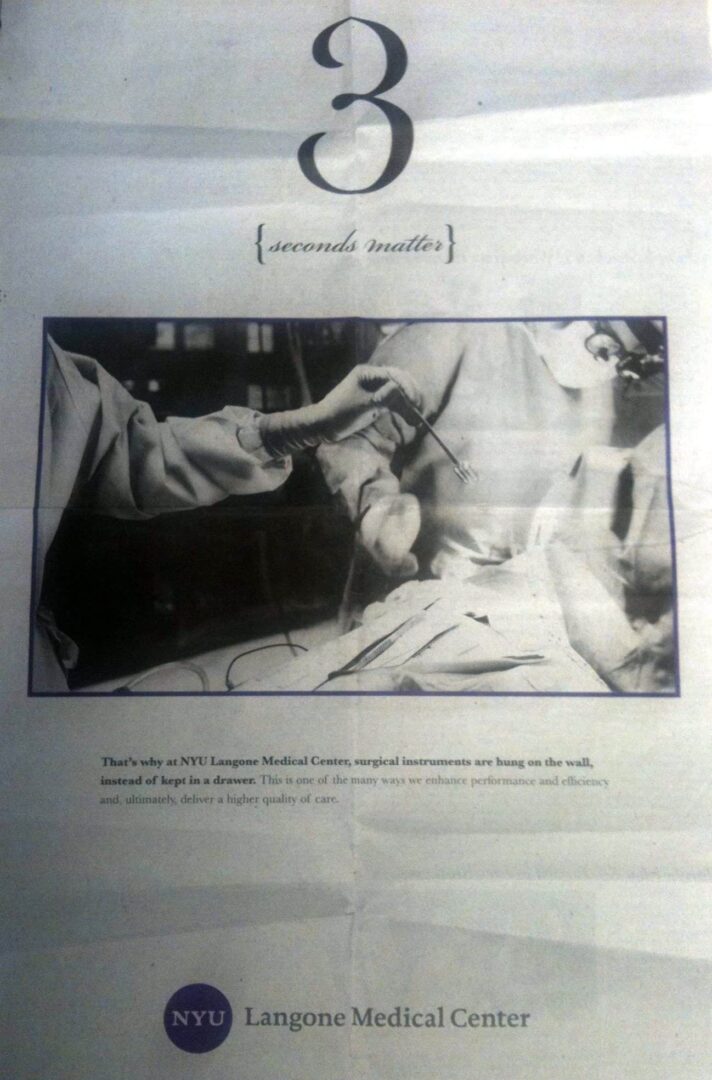 Hat tip to Helen Z. for finding this full-page print ad in the New York Times. The full ad appears below in this post, but the primary element of the ad is what you see at left – it says prominently: “3 {seconds matter}”. It's an ad for NYU Langone Medical Center, a hospital that does have a Lean program, it appears from a Google search that turns up this blog post from our friends at the Lean Insider blog.
Hat tip to Helen Z. for finding this full-page print ad in the New York Times. The full ad appears below in this post, but the primary element of the ad is what you see at left – it says prominently: “3 {seconds matter}”. It's an ad for NYU Langone Medical Center, a hospital that does have a Lean program, it appears from a Google search that turns up this blog post from our friends at the Lean Insider blog.
As you'll see, the ad depicts an operating room and says:
“That's why at NYU Langone Medical Center, surgical instruments are hung on the wall, instead of kept in a drawer. This is one of the many ways we enhance performance and efficiency and, ultimately, deliver a higher quality of care.”
So will the public buy it? Will this practice enhance their reputation amongst anyone other than “lean geeks?”
Here is the full ad (click on the picture for an even larger version):
What are your thoughts on the ad and the impression it might give? Is this really the best example of their Lean improvements, or just the most minute and concrete? Does it leave an impression that says “well, if they're paying attention to the little stuff, they must really avoid big problems” or might people think they're missing the forest for the trees? Does the ad make you more willing to visit that hospital? Take this quick poll:
[polldaddy poll=”3534451″]
If your hospital were to run a full-page ad trumpeting a Lean improvement, what would the ad say? Would you run such an ad in your hometown paper?
I'm usually not afraid to take a stand, but I'm really torn about the ad – part of me says “OK, that's good” and part of me says I'd rather see an ad trumpeting the achievement of zero central line associated bloodstream infections… does 3 seconds here and there really benefit the patient as much as major quality improvements?
I think that, if this example is indicative of a Lean culture and a true “kaizen” attitude, where you have tons of little ideas implemented by the staff, then maybe the accumulation DOES impact quality in a measurable way. But this little improvement? I don't mean to discourage their improvement, but is that ad space more of a lost opportunity than a big win?
I'm curious to learn more about their Lean efforts though… maybe I'll have a stronger view after sleeping on it, but what do you think? Scroll down or visit the blog (if you're an RSS reader) to leave a comment.
What do you think? Please scroll down (or click) to post a comment. Or please share the post with your thoughts on LinkedIn – and follow me or connect with me there.
Did you like this post? Make sure you don't miss a post or podcast — Subscribe to get notified about posts via email daily or weekly.
Check out my latest book, The Mistakes That Make Us: Cultivating a Culture of Learning and Innovation:











I like it.
Now, my major caveat is that I’m not sure of the value of advertising for hospitals at all. The major driver of patient location is doctor referral, and doctors are mostly found through either insurance programs or friends-and-family referrals. Would this make me change my hospital? Obviously not, I don’t think it would for anyone. And it’s just an ad – it could be their only bright spot. Heck, it might only have been true for a day, long enough for the marketing folks to run with it. But it’s one small step of a hospital building their reputation.
That being said, I like it because it demonstrates (as much as an ad can, see previous point) a focus on the small stuff, a focus on patient care, a focus on looking under every rock to make it better.
I believe we spend too much energy looking for the BIG wins. We want our suppliers – whether it be a hospital or a parts supplier or the grocery store – to show us the dramatic success and the life-changing impact. But healthcare, to stay within that domain, cannot be fix by 2, or even 200, changes. It’s going to take 2 million changes, and we have to start one at a time.
Perhaps this improvement is 200th on their pareto chart of impact ideas. But if the organization sees value in paying attention to something that’s 200th on their pareto chart, it gives me hope they they will go tackle the 1,000s of improvements that are necessary to really make a difference.
Jamie Flinchbaugh
http://www.jamieflinchbaugh.com
My first reaction is that it is a “features” versus “benefits” thing. “3 seconds” is a feature of their healthcare delivery. But so what? What’s the value to me as a consumer? Of course they get to that in the fine print. And maybe by so over-emphasizing the “3 seconds” they WANT you to wonder why they would even consider that as an important feature. They will likely succeed in getting people to read the benefit stated below, because why put so much emphasis on “3 seconds”? “Oh, because it will improve the quality of the care I receive.”
Also agree with Jamie that it shows that they are concerned with even the smallest details of their organization, so I might be able to extrapolate that my overall quality of care will be better.
From a lean perspective, it indirectly educates people. Suddenly it creates a link between workplace organization and quality of care that people may have never established on their own. Could plant seeds of a groundwork for understanding that could translate into other professions. “Hey, like in that Langone ad where they put tools in different places to improve quality?” Okay, maybe not likely, but I think it could help to build understanding.
This opens up a whole new frontier – Lean Marketing. Well, it’s new to ME at least.
Marketing truths are many and varied. What’s truth and what works and is truth for one segment does not work for others. Why is Geico hitting the public from so many angles?
This one particular angle they’re taking with this ad may do something for me as a lean advocate if I’m working at Langone Medical Center – recognition for our team’s efforts, now matter how seemingly small they may seem… An unintended but certainly no small benefit if they’re trying to build a Lean culture one small improvement at a time.
Frankly, after being charged $7000 for 2 hours in the ER for a kidney stone attack ($2000 out of pocket), when all I needed was medication to control pain until I could see a urologist, the only thing that’s going to resonate positively with me is what a hospital is doing to reduce the out-of-control health care cost. The whole health care debate is about having insurance for everyone — nothing about actually doing something about costs.
I use stories like this involving saving seconds to teach and instruct my staff that lots of small savings add up to significant savings after the compounding effect. However, the benefits we talk to our patients about are the same day appointment times, the improved outcomes, more service availability and the excellent customer service.
Frankly, I’m torn. As a Lean practitioner, I understand the value of the small wins. But is this “3 seconds” going to appeal to the general public and affect their healthcare decisions? I’m skeptical. And I’m with Jamie on the value of hospital advertising. Perhaps in some markets it matters, but how much?
The upside is the promotion of the value of improvement and efficiency, which is something we can always use.
Comments from people who clicked “Other” in the poll (I guess I can only see these behind the scenes)
1: “What a lot of white space… waste of paper in more than one way.”
2: “What about addressing rising health care costs?”
3: “Not the best example, may give wrong impression.”
David – how do they justify a $7,000 bill? Did they do more than give you a pain pill?
Mark, the charges included $3700 for the 2 CT Scans to see where the stone was (apparently x-ray is no longer adequate for that these days), someone to read the CT Scans, 2 hours of ER room charge, various kits to give hydrating IV’s, IV medication, the charges by the contracted ER Physician services, etc… It all adds up. The $7000 also included the approximate $500 follow-up to the urologist, where the stone passed while I was in his office. I only hope the next incident occurs when I can get access to pain medication without having to resort to the ER. (i.e. not on a holiday weekend).
I had a VP for Nursing tell me just the other day that saving a minute in ED throughput and a minute at discharge won’t change a thing. Rather, she opined that what we needed to change was physician / clinician behavior “in the middle”. While her opinion is valid (we do need to change behavior across the board), her premise is invalid: seconds and minutes add up.
I am conflicted and ask myself Jamie’s question: should a hospital be selling to the public? As a free market thinker, I would say they must. If they must, what does the consumer care about: speed or quality? How about this: 9.98 out 10 of our patients leave and don’t come back for years?
Quality trumps speed, unless speed is of the essence.
Great post, Mark!
David – I’m in favor of selling, but as long as we (the patients) have information to make an informed decision. You or I have better information about the quality of a potential car purchase than we do about our healthcare. The customer cares about quality, but most of us don’t have anything to judge that on before it’s too late.
I am having a small outpatient medical procedure on Tuesday – I have no data about the surgeon or about the surgical center. What are their infection rates? What are their costs compared to other centers? There’s not much “choice” compared to other markets. I am going to where the surgeon does his work, so no amount of advertising to me, the end consumer, would have done any good.
Healthcare is a very screwy “market.” I’m a free-market guy, but healthcare is mind-boggling, at times, compared to other industries, as I’m sure you know.